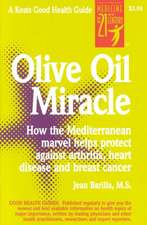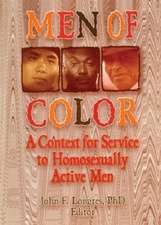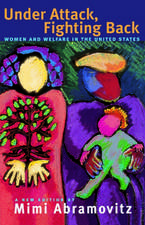The Lost Children of Wilder: The Epic Struggle to Change Foster Care
Autor Nina Bernsteinen Limba Engleză Paperback – 31 ian 2002
Vezi toate premiile Carte premiată
Literary Award (2002), Helen Bernstein Book Award (2002)
The Lost Children of Wilder gives us the galvanizing history of this landmark case and the personal story at its core. Nina Bernstein takes us behind the scenes of far-reaching legal and legislative battles, but she also traces the life of Shirley Wilder and her son, Lamont, born when Shirley was only fourteen and relinquished to the very system being challenged in her name. Bernstein’s account of Shirley and Lamont’s struggles captures the heartbreaking consequences of the child welfare system’s best intentions and deepest flaws. In the tradition of There Are No Children Here, this is a major achievement of investigative journalism and a tour de force of social observation, a gripping book that will haunt every reader who cares about the needs of children.
Preț: 117.69 lei
Nou
Puncte Express: 177
Preț estimativ în valută:
22.52€ • 23.58$ • 18.63£
22.52€ • 23.58$ • 18.63£
Carte disponibilă
Livrare economică 17-31 martie
Preluare comenzi: 021 569.72.76
Specificații
ISBN-13: 9780679758341
ISBN-10: 0679758348
Pagini: 496
Dimensiuni: 133 x 205 x 27 mm
Greutate: 0.36 kg
Ediția:Vintage Books.
Editura: VINTAGE BOOKS
Locul publicării:New York, NY
ISBN-10: 0679758348
Pagini: 496
Dimensiuni: 133 x 205 x 27 mm
Greutate: 0.36 kg
Ediția:Vintage Books.
Editura: VINTAGE BOOKS
Locul publicării:New York, NY
Notă biografică
Nina Bernstein lives in New York City.
Extras
Chapter 3
There was still snow on the ground the day Shirley Wilder and another girl followed a dirt road at the upper end of the grounds into the woods, hunting for a way out. The road soon vanished among the drifts and wet black tree trunks. Moving through the shadows of a grove of cedars, they suddenly found themselves in a clearing at the edge of a steep, wooded ravine.
It was a small cemetery. The old gravestones had been so tilted by spring frosts and winter thaws that they looked almost scattered. There were no dates on the weathered markers, and no epitaphs—only girls' names, fading from bare limestone.
Lizzie French. Nellie McGovern. Anna Schabesberger. Julia Coon. Mary O'Brien. Louella Roarack. Lydia Althouser. Jennie Fuller. Barbara Decker. Anne Withey. Helen Peer.
Shirley remembered the stories she had heard from a housemother and some of the girls. They said a secret graveyard lay hidden in the woods on the Hudson grounds. Years ago, dead babies born to inmates were buried there, and bad girls, too—girls caught trying to escape who later died inside the institution. Other bodies were sent home to their folks for burial, but even after death, runaways were punished. This was their solitary confinement: a cold, dark grave lost in the woods forever.
Shirley began to tremble, and the other girl cried out in fright. They turned and ran away as fast as they could.
At the other end of the Hudson grounds they climbed over the fence together and slid down a slope into a stubble of cattails and frozen loosestrife. For hours they stumbled through the big swamp that bordered the institution, looking for a road out. Pockets of ice cracked underfoot and gave way to marshy ground. They fell and scrambled upright again, foul-smelling muck soaking their shoes and clothes. Running, trudging, running again, they couldn't escape the icy wind that whipped in off the river. They clutched at stiff weeds with raw fingers to keep from slipping. Shirley's feet swelled, and her ears went numb with cold.
They were lost, lost in the vast wetland that had once been the South Bay.
Whaling ships were moored here in another century. The first ones carried the town's founders, prosperous whalers from Nantucket and Martha's Vineyard who came seeking a safer harbor in the revolutionary world of 1783. The Proprieters, as later generations would call them, sailed up the Hudson with all their goods lashed to the decks of their ships, even their disassembled houses. In later years, tugboats idled in the South Bay after guiding great shipping vessels to the deep-water wharves on Hudson's Front Street. In the 1840s, when impoverished tenant farmers rebelled against their vassalage under Hudson Valley landowners, troopships sailed here, too, bringing soldiers to crush the revolt.
Then the railroad arrived. The New York-to-Albany line was laid on causeways right across the mouth of the South Bay, cutting it off from the river in 1851. An iron factory spewed its wastes into the stranded bay. The bay became a putrid swamp. And on a promontory above this swamp, the House of Refuge for Women was built. The word Refuge was misleading: from the moment the stone and wrought iron gates of the institution first swung open on May 7, 1887, solitary confinement was the preferred mode of treatment.
"Though I have been very much impeded by the newness of the institution in my desire to enforce rigorous discipline," Sarah V. Coon, the first superintendent, reported in November 1888, "still so far as it has been possible in our overcrowded prison, I have tried to isolate each girl, upon her arrival, from the older inmates. . . . Sometimes, upon detecting a developing tendency to misbehave, I still keep her in solitary confinement until I see a change in this respect. . . . Besides solitary confinement, confinement in dark cells, with disciplinary diet and handcuffs, is in vogue."
Shirley, scrambling through the marsh in the slanting winter light of 1973, was one in a long line of girls who had tried to escape this form of education. Most were quickly apprehended. The very first inmate committed to the institution after it was dubbed the New York State Training School for Girls in 1904 was a thirteen-year-old named Rose Conte who ran away at four o'clock that July day and was caught by nine p.m.
A few got away. "Twenty-five Dollars Reward," announced the Hudson Gazette on November 14, 1895. "Saturday last a reward of $25 was offered for the return of Catharine Burns, who escaped from the House of Refuge for Women in this city on the night of October 23. The woman is described as being 23 years of age, 5 feet 71/2 inches tall, very dark hair, large, dark blue eyes, strongly marked dark eyebrows, pale complexion, well proportioned and rather striking in appearance."
Catharine Burns was never found. Perhaps she melted into one of the lost colonies of runaways that people the legends of the Hudson River Valley. But to Shirley, a city child lost in a tangle of scrub oak and swamp hickory, the wilderness held no promise of refuge. At last, through thickening woods and gathering dusk, she saw the lights of a house and ran to it.
A fire was blazing in the grate. A woman was at home. When she answered the door, Shirley begged her for help. Would she please call a taxi to take them to the city? The woman agreed and invited the two shivering girls inside to warm themselves at her hearth. They were so grateful. They were still huddled there, holding their hands out to the flames, when the Hudson security guard walked in to take them back.
Shirley spent three days in solitary confinement as punishment for running away. When she emerged from isolation, she was transferred into the new Behavior Modification Unit in Cottage E.
Cottage E was the last building in the far quadrangle, the closest to the woods that hid the old cemetery. Beyond the graves, blocked from view by trees, stood the superintendent's house. It was a mansion, really, built in the Federal style when the rolling grounds were still a rich man's estate. Embellished in the mid–nineteenth century, it boasted an Italianate tower, octagonal halls with big bay windows, and a stone veranda with a commanding view over the trees to the mountains.
One after another the institution's superintendents had lived there. Tom Tunney, arriving with his wife and four children in 1965, was the last. The state provided the residence free of charge and supplied a staff to match: a uniformed chauffeur, maintenance men to tend the temperamental furnace, a gardener, a cook, and a full-time housekeeper. Traditionally, ten girls worked under the housekeeper's direction. They kept the marble fireplaces clean and dusted the grand circular staircase; they washed and ironed the family laundry in the basement; they peeled and chopped and scoured in the kitchen. Some served at table, answering the summons of a peremptory bell. The girls were not paid, of course. This was "vocational training."
Gale Smith, Tunney's right-hand man, knew it was typical throughout the training-school system. "There were always kids who worked in the superintendent's home. It was patterned after the old system of county sheriffs who had control in their bailiwick and prison inmates working for them. It was all part of English tradition. Some of the training schools had a tailor who would actually tend to the family's needs. Most of them managed their own storehouse, and the superintendent's house got the choice cuts from the meat. They were little fiefdoms."
For Tunney, a white liberal who had spent the summer of 1964 in Mississippi agitating for Negro civil rights, what came to mind was not England but the antebellum South. His first week at the institution he said to his wife, "My God, Patty, I've got a plantation here to run."
By then, most of the girls at Hudson were black. Perhaps 35 percent of the staff was, too; many came from black families that had lived for generations in the town of Hudson. Tunney's first proclamation put a halt to the unpaid labor of inmates in the mansion. When he learned that many staff members were taking girls to their own homes to do laundry and cleaning under the guise of "vocational training," he decreed that the inmates would have to be paid two dollars an hour. "Suddenly not too many people wanted to take the girls," he would remember.
But the institution itself remained dependent on the inmates' unpaid work. Not only were society's narrowest expectations for young women embodied in the vocational-education courses—homemaking, cooking, and beauty culture topped the list—but all "vocational assignments" had to be fitted into the maintenance needs of the institution. There were, for example, no janitors at Hudson because the girls did all the cleaning—in the academic school, the chapel, and the administration building as well as the cottages. They also did the laundry, including linens for several other state facilities, on equipment rated "altogether obsolete" by inspectors. To accommodate the workload, many of the girls went to school only in the morning or the afternoon, or two to three days a week. No girl's room had a desk, no cottage a space for study; the school's sparsely supplied library was open to inmates for forty minutes, once a week. Most inmates would be at a serious disadvantage when they returned to their community schools. The irony was that many had been committed to Hudson as truants.
In 1972, after Tunney's own children went off to college, he moved out of the big house into a more modest farmhouse on the grounds. In 1973, when Shirley Wilder arrived at Hudson, the superintendent's mansion stood unused and overgrown, like the old cemetery below it.
Tunney thought he had broken with his predecessors. A Korean War air force veteran turned registered Socialist and student of Buddhism, he saw himself as a radical reformer unafraid of controversy. "When I came here there were 350 kids and the place was a mess," he would say. "My idea was to close it down. I wanted to close them all down."
In his first years at Hudson, Tunney did close Cottage A, the punishment cottage that had operated since the 1920s; but then he built isolation cells into the old hospital building instead. Few if any of his supporters knew the institution's history well enough to appreciate the irony: the hospital, remodeled several times, had started out as the prison building at the House of Refuge. Its prison cells had been superseded at the turn of the century by a "guard-house . . . where girls may be put into solitary confinement." The guardhouse in turn had been replaced by a disciplinary cottage—Cottage A. Now the site of punishment had come full circle.
The hospital cells were backed up, of course, by the Brookwood Annex. "Annex units of this type are common in several states and they are in every sense disciplinary cottages ‘away from home,' " Giallombardo, the sociologist, noted in 1973. "Held as a threat to any inmate who resists outward conformity to institutional rules, the units provide the same function as would a maximum security cottage located on the grounds. In addition, its location elsewhere makes it possible to present a public image of the institution that is less than the whole truth, if not altogether false."
Mindful of the harshness of Brookwood's regime, Tunney decided to create an experimental alternative—a behavior-modification unit. It was to be an enlightened version of the annex, a state-of-the-art application of B. F. Skinner's work to the treatment of juvenile delinquency. Instead, it would become another place of punishment reverberating with echoes of a forgotten past. like tunney, josephine shaw lowell, the nineteenth-century social reformer whose tough-minded campaign first established the Hudson House of Refuge for Women, saw herself as a radical. She came from a distinguished family of abolitionists. Her brother, Robert Gould Shaw, had died leading the first Negro regiment in the Civil War; her father had organized the Freedmen's Bureau; and she began her lifelong charitable work by inspecting black schools in the South and raising relief funds for freed slaves. Appalled by conditions in New York's poorhouses and jails, where the Irish had predominated since the great migration of the Irish Famine, she fought for policies that she thought would eliminate poverty, not just cope with its consequences. She became a leader among the new "scientific" social reformers who focused on family patterns as the primary source of poverty and social disorder, and on the role they believed indiscriminate charity played in perpetuating those patterns.
Nineteenth-century ideology had cast the "true woman" as the guardian of social morality, and her home as a haven from the marketplace, where the next generation would learn industriousness and Christian virtue. But by the 1870s, fears about the formation of a permanent class of paupers and criminals had turned the cult of true womanhood on its head: the "fallen woman" was seen as the progenitor of idle and vicious generations that drained the resources of the republic and threatened its stability.
"One of the most important and most dangerous causes of the increase of crime, pauperism and insanity, is the unrestrained liberty allowed to vagrant and degraded women," Lowell told New York's state legislature in 1879, in arguing for the creation of a reformatory for women under the management of women. "There are two distinct and separate objects to be aimed at in dealing with these women: To reform them if possible, but if that cannot be done, at least to cut off the line of hereditary pauperism, crime and insanity, now transmitted mainly through them."
The hybrid reformatories that Lowell envisioned for female offenders and young mothers of illegitimate children were to provide a kind of reprogramming in "true womanhood" through an institutional replication of family life, isolated from the outer world. When the state finally opened the House of Refuge in 1887, "as an experiment," it embodied most of Lowell's plan and all its contradictions.
The targets, typically convicted of prostitution or vagrancy, had been subject in the past to terms of ten days to half a year in jail or the county poorhouse. Now they were sentenced to Hudson for five years, with earlier release only at the discretion of their keepers. In the shadow of the ninety-six-cell prison building where inmates spent at least the first two months, cottages housing fifteen to twenty young women were "fitted up as nearly as possible like an average family home for the purpose of teaching inmates all manner of domestic work." They were at times allowed to talk to each other in "a low, pleasant voice," but only under the eyes of the supervisor, "who checks any boisterousness or unladylike manner," as Coon, the first superintendent, reported. Even unhappiness was cause for reproof. A complicated point scale was used to grade inmate behavior, backed by a system of surveillance, denunciation, and self-confession for such small faults as tilting a chair or sitting on a bed. "So much attention is given to these minute points that a girl, it is considered, can not attain 100 as an average at any time." Room confinement on bread and water was standard punishment for breaking rules designed as much to ensure the smooth functioning of the institution as to remake a "bad" girl into a "respectable" woman.
But the results were often disappointing, to judge from the oversized parole ledgers stacked and forgotten in the basement of a Hudson administration building. To be sure, sometimes a young girl or woman was reported to be "doing well" after discharge—married, employed as a servant by a "respectable" family, or living with her parents. But most entries were less sanguine. "Dora Miller . . . did well for a few months, then went back to an evil life," reads the entry on a Jewish girl born in Berlin who "had worked in a collar shop" before spending three years at the institution for disorderly conduct. "Went to pieces immediately after final discharge and now acting disgracefully in Troy," is the report on Mamie King, who had spent five full years at Hudson.
The institution itself rapidly declined. The site on the bluff above the river had seemed so healthful to the founders when they chose it. But by 1899, in its twelfth annual report, the board of managers called the need for sewerage urgent, "the dungeons . . . damp and cold," "the ceilings in the main building and in the cottages . . . poor, many of them having already fallen and others in danger of falling hourly." Later reports complained of harmful overcrowding, girls sleeping in corridors, and a nearby cement works that emitted "noxious gases and blinding clouds of dust which have harassed the residents of this institution for some years." Again and again the board begged the state legislature for funds "to bring the Institution up to the real purposes of a Reformatory."
Meanwhile, the ledgers filled with names and numbers, and sometimes, in the woods, another grave was dug.
Here lay Anna Louise Schabesberger, five months old, who died on May 7, 1892, the fifth anniversary of the day the House of Refuge's gates opened. Here, too, lay Anna Schabesberger, the baby's twenty-one-year-old unwed mother, who died giving birth to her namesake. She was inmate number 338, a German immigrant and domestic servant committed from Yonkers for petit larceny soon after she became pregnant by an unnamed man.
Here lay Nellie McGovern, a New York City child of Irish immigrants, who was eighteen and said to be married when she died at Hudson in the winter of 1894, suffering from syphilis and childbirth fever. A child named Michael McGovern died four months later at Mt. Loretto, Staten Island, a Catholic orphanage also known as the Mission of the Immaculate Virgin.
Mary O'Brien: sent to the House of Refuge at sixteen as a "common prostitute," she died of tuberculosis after two years there, on September 26, 1894, her occupation listed as "domestic" on her death certificate.
Lizzie French. She was only fourteen and reported to be in good health when she was sent behind the high board fence to be reformed; she had been working in a caramel shop in Troy, New York, and was committed for petit larceny three weeks before Christmas 1892. She died of tuberculosis when she was seventeen.
Julia Coon: an unwed housekeeper, half German, half Irish; she died at twenty in June of 1893 in childbirth, two months after her commitment as a "disorderly person." There is no record of what happened to her baby or who its father was.
Helen Peer: she died at twenty-one in the spring of 1896, suffering from syphilis and "chronic diarrhea"—probably typhus contracted after three years in the unsewered House of Refuge, where the only drinking water came from the polluted Hudson. A collarmaker by trade, she had been convicted of being a vagrant in Glens Falls, New York, after the bitter depression winter of 1893.
By then, reformer Josephine Shaw Lowell had come to see low wages and unemployment, not family patterns and charity, as the primary causes of pauperism. She began to support organized labor and binding arbitration; she raised money for striking garment workers; she founded a consumers' league to boycott stores that underpaid and overworked salesgirls. But the Hudson "experiment" she had launched continued.
As part of tunney's behavior modification unit (BMU) in Cottage E, Shirley Wilder became the subject of a system of grading and scrutiny. In the BMU, nothing came free except a bare bed and food on a tray in room confinement. Tokens were charged each day for the privilege of eating in the dining room, having a lamp in one's room, having window curtains.
"They would earn so many tokens for going through the day without a problem, and they would lose tokens if they would have a problem—act out, throw food, have an argument with another person," Betty Williams, one of the BMU housemothers, would recall. "Some kids just got worse. They got so deep in the hole, they just didn't care.
"We did some modification of the whole twenty-five kids at the end. It was too many kids. At most you'd have three staff to do that. It's not enough to deal with normal kids, whatever normal is."
Shirley hated the BMU. "The counselors would hit you like you were a man," she said. "We had to mop the corridors and the bathroom on hands and knees with a rag. We was nobodies."
To Gale Smith, head of programs for Tunney, the problem was that the staff was too warm. In order to run this kind of operation, he felt, staff had to be extremely objective, almost cold and detached. "On our staff we had some of the most nurturing, caring ladies you can imagine."
There were other hindrances. During the early 1970s every major newspaper in the United States, including the New York Times, published exposés of conditions in the juvenile penal system. Class-action lawsuits and investigative commissions around the country criticized state institutions for internal abuses ranging from sexual violence and solitary confinement to the punitive use of psychotropic drugs. The bad publicity led New York to create the short-lived post of state ombudsman for children. Tunney found that ombudsman interference frustrated the behavior-modification system. "The ombudsman would come in and say, ‘You can't deprive kids of going into the dining room.' The big thing was children's rights."
Even as he clashed with the ombudsman, though, Tunney increasingly caught himself wondering if he was doing harm rather than good: "We just don't know enough to help, and we get desperate in our efforts to help, and we do damage in our efforts to help."
It was so hard to change even a small detail of institutional life. Toilet paper, for instance. Girls were given a roll of toilet paper once a month, or else the staff doled out four sheets of paper each as the girls lined up to go to the bathroom. As far as staff members were concerned, there was no choice. They had only so much toilet paper, so they devised ways to make it last. The underlying problem turned out to be that the training schools ordered toilet paper in bulk based upon the needs of boys. Tunney and Smith spent months figuring this out and writing memos to change it. But the hardest part came after they succeeded in increasing Hudson's toilet-paper allocation.
"We had a hell of a time convincing the staff to put toilet-paper holders in the bathrooms," Smith would recall.
"They said the kids would waste toilet paper, they would shine their shoes with it, plug the toilet with it. It took a long time to convince them that there was almost an endless supply of toilet paper in the world."
Everything was in this toilet-paper anecdote: the humiliation of everyday life for young girls in the institution, the system's ingrained sexism, the power of bureaucratic inertia, the niggardly budget, the staff that actually preferred the power of administering scarcity to the loss of control entailed by abundance. No small victory against such entrenched forces could be considered permanent.
Reform was in the eye of the beholder, anyway. The pattern in social welfare seemed to be for one generation's hard-won program to be attacked for its abuses and dismantled by a later generation—only to resurface again as a promising innovation in the next era of reform.
An earlier reformer, Gloria McFarland, the institution's psychologist in the 1950s and early 1960s, had particularly hated the baby nursery that still existed at the Hudson of the 1950s. It was her task to screen infants born to Hudson inmates for any signs of retardation that would make them unadoptable. In the unit in the Hudson infirmary where they waited for placement in foster care or adoptive homes, babies languished. "Weeks would pass," McFarland would recall. "The babies got marasmus—they were depressed because the girls didn't pay any attention to them."
Marasmus is a wasting-away of the flesh with no organic cause, a failure to thrive in the absence of love that can be as fatal for a baby as meningitis or pneumonia. Examining skinny, listless infants in their cribs, McFarland was haunted by the thought of the overgrown cemetery and the dead babies said to be buried there. She fought to have the nursery closed, and eventually she succeeded.
With the nursery gone, the state stopped committing pregnant girls to Hudson. Then Tunney and Smith arrived and decried the lack of services for Hudson girls who turned up pregnant. Private maternity programs refused to take them, and some were in the streets without prenatal care. So Tunney and Smith created a special unit for them in one of the cottages. But the girls couldn't keep their babies. Eventually, new reformers began to push for the opening of institutional nurseries as a means of rehabilitating young women and preserving families.
At heart, Tunney believed all institutions were harmful. His career had started at a mental hospital in Arizona and included a maximum-security prison in Wisconsin and the girls' reformatory in that state. "One problem is that institutions begin to deal with problems that were not even problems before the child went to the institution," he would explain. "Everybody knows whether your shirttail should be in or out and your hair combed and whether you should swear. Nobody knows how to deal with a girl's sexual promiscuity. So you set up rules around shirttails and swearing and the things you know, and then you start to get children punished for breaking those rules. And you can sit there and see that it isn't doing a damn bit of good."
He could not really defend the practice of isolating children in distress, for example. Staff should hold or stay with a girl in danger of hurting herself, he said, but he had never had enough staff to do that. Still, he kept trying. Tunney had what he called a "Buddhist perspective on things": "In the beginning I felt, ‘What I'm doing isn't very important, but it's very important that I do it. Whatever's in front of you, do as well as you can.' In my middle years, I felt, ‘What I'm doing is not very important, and it's not very important that I do it, but there's nothing else I can do'—not with a sense of futility, but with the feeling that once in a while you could be helped by one of your clients or patients, and we're in this thing together, and how much I'm learning, understanding, and growing. I despaired of ever trying to make it prettier, but I tried to make myself as pretty as possible."
A month before Shirley Wilder arrived, an internal report by the State Division for Youth had declared Tunney's institution "both obsolescent as a child-caring facility and obsolete as a physical plant." But though its budget had been cut back by a third, the report cautioned, the training school remained one of the biggest employers in Hudson: "To close the school, cancel the payroll and eliminate a large customer of local goods and services would damage the economy of this depressed city, and, for that reason, could be a politically difficult matter to accomplish. This aspect has deterred construction of a replacement training school closer to New York City."
It was an unusually candid admission of how political and economic interests vested in the status quo outweighed changes in professional wisdom about what children needed. There was a special irony in the economic benefit Hudson had reaped for nearly a century from its reformatory for young prostitutes and other sexually misbehaving females: the town had simultaneously cashed in on a flourishing, nationally notorious red-light district. In the earliest days, the town founders had tolerated bawdy houses and grogshops because they catered to the transient sailors and wagon drivers who served the inland port. In the 1920s and 1930s, "Legs" Diamond was one of the bootlegging gangsters whose steamboat patronage boosted Hudson's reputation as a center of vice. The thriving brothels that lined Diamond Street near the deep-water wharves became a valued part of the local economy. A state crackdown in 1950 ended the era of openly organized prostitution, but decades later retired merchants were still regretting its demise.
And in the end Tom Tunney, who had arrived with the dream of closing the training school, joined local businessmen in lobbying to keep it open.
There was still snow on the ground the day Shirley Wilder and another girl followed a dirt road at the upper end of the grounds into the woods, hunting for a way out. The road soon vanished among the drifts and wet black tree trunks. Moving through the shadows of a grove of cedars, they suddenly found themselves in a clearing at the edge of a steep, wooded ravine.
It was a small cemetery. The old gravestones had been so tilted by spring frosts and winter thaws that they looked almost scattered. There were no dates on the weathered markers, and no epitaphs—only girls' names, fading from bare limestone.
Lizzie French. Nellie McGovern. Anna Schabesberger. Julia Coon. Mary O'Brien. Louella Roarack. Lydia Althouser. Jennie Fuller. Barbara Decker. Anne Withey. Helen Peer.
Shirley remembered the stories she had heard from a housemother and some of the girls. They said a secret graveyard lay hidden in the woods on the Hudson grounds. Years ago, dead babies born to inmates were buried there, and bad girls, too—girls caught trying to escape who later died inside the institution. Other bodies were sent home to their folks for burial, but even after death, runaways were punished. This was their solitary confinement: a cold, dark grave lost in the woods forever.
Shirley began to tremble, and the other girl cried out in fright. They turned and ran away as fast as they could.
At the other end of the Hudson grounds they climbed over the fence together and slid down a slope into a stubble of cattails and frozen loosestrife. For hours they stumbled through the big swamp that bordered the institution, looking for a road out. Pockets of ice cracked underfoot and gave way to marshy ground. They fell and scrambled upright again, foul-smelling muck soaking their shoes and clothes. Running, trudging, running again, they couldn't escape the icy wind that whipped in off the river. They clutched at stiff weeds with raw fingers to keep from slipping. Shirley's feet swelled, and her ears went numb with cold.
They were lost, lost in the vast wetland that had once been the South Bay.
Whaling ships were moored here in another century. The first ones carried the town's founders, prosperous whalers from Nantucket and Martha's Vineyard who came seeking a safer harbor in the revolutionary world of 1783. The Proprieters, as later generations would call them, sailed up the Hudson with all their goods lashed to the decks of their ships, even their disassembled houses. In later years, tugboats idled in the South Bay after guiding great shipping vessels to the deep-water wharves on Hudson's Front Street. In the 1840s, when impoverished tenant farmers rebelled against their vassalage under Hudson Valley landowners, troopships sailed here, too, bringing soldiers to crush the revolt.
Then the railroad arrived. The New York-to-Albany line was laid on causeways right across the mouth of the South Bay, cutting it off from the river in 1851. An iron factory spewed its wastes into the stranded bay. The bay became a putrid swamp. And on a promontory above this swamp, the House of Refuge for Women was built. The word Refuge was misleading: from the moment the stone and wrought iron gates of the institution first swung open on May 7, 1887, solitary confinement was the preferred mode of treatment.
"Though I have been very much impeded by the newness of the institution in my desire to enforce rigorous discipline," Sarah V. Coon, the first superintendent, reported in November 1888, "still so far as it has been possible in our overcrowded prison, I have tried to isolate each girl, upon her arrival, from the older inmates. . . . Sometimes, upon detecting a developing tendency to misbehave, I still keep her in solitary confinement until I see a change in this respect. . . . Besides solitary confinement, confinement in dark cells, with disciplinary diet and handcuffs, is in vogue."
Shirley, scrambling through the marsh in the slanting winter light of 1973, was one in a long line of girls who had tried to escape this form of education. Most were quickly apprehended. The very first inmate committed to the institution after it was dubbed the New York State Training School for Girls in 1904 was a thirteen-year-old named Rose Conte who ran away at four o'clock that July day and was caught by nine p.m.
A few got away. "Twenty-five Dollars Reward," announced the Hudson Gazette on November 14, 1895. "Saturday last a reward of $25 was offered for the return of Catharine Burns, who escaped from the House of Refuge for Women in this city on the night of October 23. The woman is described as being 23 years of age, 5 feet 71/2 inches tall, very dark hair, large, dark blue eyes, strongly marked dark eyebrows, pale complexion, well proportioned and rather striking in appearance."
Catharine Burns was never found. Perhaps she melted into one of the lost colonies of runaways that people the legends of the Hudson River Valley. But to Shirley, a city child lost in a tangle of scrub oak and swamp hickory, the wilderness held no promise of refuge. At last, through thickening woods and gathering dusk, she saw the lights of a house and ran to it.
A fire was blazing in the grate. A woman was at home. When she answered the door, Shirley begged her for help. Would she please call a taxi to take them to the city? The woman agreed and invited the two shivering girls inside to warm themselves at her hearth. They were so grateful. They were still huddled there, holding their hands out to the flames, when the Hudson security guard walked in to take them back.
Shirley spent three days in solitary confinement as punishment for running away. When she emerged from isolation, she was transferred into the new Behavior Modification Unit in Cottage E.
Cottage E was the last building in the far quadrangle, the closest to the woods that hid the old cemetery. Beyond the graves, blocked from view by trees, stood the superintendent's house. It was a mansion, really, built in the Federal style when the rolling grounds were still a rich man's estate. Embellished in the mid–nineteenth century, it boasted an Italianate tower, octagonal halls with big bay windows, and a stone veranda with a commanding view over the trees to the mountains.
One after another the institution's superintendents had lived there. Tom Tunney, arriving with his wife and four children in 1965, was the last. The state provided the residence free of charge and supplied a staff to match: a uniformed chauffeur, maintenance men to tend the temperamental furnace, a gardener, a cook, and a full-time housekeeper. Traditionally, ten girls worked under the housekeeper's direction. They kept the marble fireplaces clean and dusted the grand circular staircase; they washed and ironed the family laundry in the basement; they peeled and chopped and scoured in the kitchen. Some served at table, answering the summons of a peremptory bell. The girls were not paid, of course. This was "vocational training."
Gale Smith, Tunney's right-hand man, knew it was typical throughout the training-school system. "There were always kids who worked in the superintendent's home. It was patterned after the old system of county sheriffs who had control in their bailiwick and prison inmates working for them. It was all part of English tradition. Some of the training schools had a tailor who would actually tend to the family's needs. Most of them managed their own storehouse, and the superintendent's house got the choice cuts from the meat. They were little fiefdoms."
For Tunney, a white liberal who had spent the summer of 1964 in Mississippi agitating for Negro civil rights, what came to mind was not England but the antebellum South. His first week at the institution he said to his wife, "My God, Patty, I've got a plantation here to run."
By then, most of the girls at Hudson were black. Perhaps 35 percent of the staff was, too; many came from black families that had lived for generations in the town of Hudson. Tunney's first proclamation put a halt to the unpaid labor of inmates in the mansion. When he learned that many staff members were taking girls to their own homes to do laundry and cleaning under the guise of "vocational training," he decreed that the inmates would have to be paid two dollars an hour. "Suddenly not too many people wanted to take the girls," he would remember.
But the institution itself remained dependent on the inmates' unpaid work. Not only were society's narrowest expectations for young women embodied in the vocational-education courses—homemaking, cooking, and beauty culture topped the list—but all "vocational assignments" had to be fitted into the maintenance needs of the institution. There were, for example, no janitors at Hudson because the girls did all the cleaning—in the academic school, the chapel, and the administration building as well as the cottages. They also did the laundry, including linens for several other state facilities, on equipment rated "altogether obsolete" by inspectors. To accommodate the workload, many of the girls went to school only in the morning or the afternoon, or two to three days a week. No girl's room had a desk, no cottage a space for study; the school's sparsely supplied library was open to inmates for forty minutes, once a week. Most inmates would be at a serious disadvantage when they returned to their community schools. The irony was that many had been committed to Hudson as truants.
In 1972, after Tunney's own children went off to college, he moved out of the big house into a more modest farmhouse on the grounds. In 1973, when Shirley Wilder arrived at Hudson, the superintendent's mansion stood unused and overgrown, like the old cemetery below it.
Tunney thought he had broken with his predecessors. A Korean War air force veteran turned registered Socialist and student of Buddhism, he saw himself as a radical reformer unafraid of controversy. "When I came here there were 350 kids and the place was a mess," he would say. "My idea was to close it down. I wanted to close them all down."
In his first years at Hudson, Tunney did close Cottage A, the punishment cottage that had operated since the 1920s; but then he built isolation cells into the old hospital building instead. Few if any of his supporters knew the institution's history well enough to appreciate the irony: the hospital, remodeled several times, had started out as the prison building at the House of Refuge. Its prison cells had been superseded at the turn of the century by a "guard-house . . . where girls may be put into solitary confinement." The guardhouse in turn had been replaced by a disciplinary cottage—Cottage A. Now the site of punishment had come full circle.
The hospital cells were backed up, of course, by the Brookwood Annex. "Annex units of this type are common in several states and they are in every sense disciplinary cottages ‘away from home,' " Giallombardo, the sociologist, noted in 1973. "Held as a threat to any inmate who resists outward conformity to institutional rules, the units provide the same function as would a maximum security cottage located on the grounds. In addition, its location elsewhere makes it possible to present a public image of the institution that is less than the whole truth, if not altogether false."
Mindful of the harshness of Brookwood's regime, Tunney decided to create an experimental alternative—a behavior-modification unit. It was to be an enlightened version of the annex, a state-of-the-art application of B. F. Skinner's work to the treatment of juvenile delinquency. Instead, it would become another place of punishment reverberating with echoes of a forgotten past. like tunney, josephine shaw lowell, the nineteenth-century social reformer whose tough-minded campaign first established the Hudson House of Refuge for Women, saw herself as a radical. She came from a distinguished family of abolitionists. Her brother, Robert Gould Shaw, had died leading the first Negro regiment in the Civil War; her father had organized the Freedmen's Bureau; and she began her lifelong charitable work by inspecting black schools in the South and raising relief funds for freed slaves. Appalled by conditions in New York's poorhouses and jails, where the Irish had predominated since the great migration of the Irish Famine, she fought for policies that she thought would eliminate poverty, not just cope with its consequences. She became a leader among the new "scientific" social reformers who focused on family patterns as the primary source of poverty and social disorder, and on the role they believed indiscriminate charity played in perpetuating those patterns.
Nineteenth-century ideology had cast the "true woman" as the guardian of social morality, and her home as a haven from the marketplace, where the next generation would learn industriousness and Christian virtue. But by the 1870s, fears about the formation of a permanent class of paupers and criminals had turned the cult of true womanhood on its head: the "fallen woman" was seen as the progenitor of idle and vicious generations that drained the resources of the republic and threatened its stability.
"One of the most important and most dangerous causes of the increase of crime, pauperism and insanity, is the unrestrained liberty allowed to vagrant and degraded women," Lowell told New York's state legislature in 1879, in arguing for the creation of a reformatory for women under the management of women. "There are two distinct and separate objects to be aimed at in dealing with these women: To reform them if possible, but if that cannot be done, at least to cut off the line of hereditary pauperism, crime and insanity, now transmitted mainly through them."
The hybrid reformatories that Lowell envisioned for female offenders and young mothers of illegitimate children were to provide a kind of reprogramming in "true womanhood" through an institutional replication of family life, isolated from the outer world. When the state finally opened the House of Refuge in 1887, "as an experiment," it embodied most of Lowell's plan and all its contradictions.
The targets, typically convicted of prostitution or vagrancy, had been subject in the past to terms of ten days to half a year in jail or the county poorhouse. Now they were sentenced to Hudson for five years, with earlier release only at the discretion of their keepers. In the shadow of the ninety-six-cell prison building where inmates spent at least the first two months, cottages housing fifteen to twenty young women were "fitted up as nearly as possible like an average family home for the purpose of teaching inmates all manner of domestic work." They were at times allowed to talk to each other in "a low, pleasant voice," but only under the eyes of the supervisor, "who checks any boisterousness or unladylike manner," as Coon, the first superintendent, reported. Even unhappiness was cause for reproof. A complicated point scale was used to grade inmate behavior, backed by a system of surveillance, denunciation, and self-confession for such small faults as tilting a chair or sitting on a bed. "So much attention is given to these minute points that a girl, it is considered, can not attain 100 as an average at any time." Room confinement on bread and water was standard punishment for breaking rules designed as much to ensure the smooth functioning of the institution as to remake a "bad" girl into a "respectable" woman.
But the results were often disappointing, to judge from the oversized parole ledgers stacked and forgotten in the basement of a Hudson administration building. To be sure, sometimes a young girl or woman was reported to be "doing well" after discharge—married, employed as a servant by a "respectable" family, or living with her parents. But most entries were less sanguine. "Dora Miller . . . did well for a few months, then went back to an evil life," reads the entry on a Jewish girl born in Berlin who "had worked in a collar shop" before spending three years at the institution for disorderly conduct. "Went to pieces immediately after final discharge and now acting disgracefully in Troy," is the report on Mamie King, who had spent five full years at Hudson.
The institution itself rapidly declined. The site on the bluff above the river had seemed so healthful to the founders when they chose it. But by 1899, in its twelfth annual report, the board of managers called the need for sewerage urgent, "the dungeons . . . damp and cold," "the ceilings in the main building and in the cottages . . . poor, many of them having already fallen and others in danger of falling hourly." Later reports complained of harmful overcrowding, girls sleeping in corridors, and a nearby cement works that emitted "noxious gases and blinding clouds of dust which have harassed the residents of this institution for some years." Again and again the board begged the state legislature for funds "to bring the Institution up to the real purposes of a Reformatory."
Meanwhile, the ledgers filled with names and numbers, and sometimes, in the woods, another grave was dug.
Here lay Anna Louise Schabesberger, five months old, who died on May 7, 1892, the fifth anniversary of the day the House of Refuge's gates opened. Here, too, lay Anna Schabesberger, the baby's twenty-one-year-old unwed mother, who died giving birth to her namesake. She was inmate number 338, a German immigrant and domestic servant committed from Yonkers for petit larceny soon after she became pregnant by an unnamed man.
Here lay Nellie McGovern, a New York City child of Irish immigrants, who was eighteen and said to be married when she died at Hudson in the winter of 1894, suffering from syphilis and childbirth fever. A child named Michael McGovern died four months later at Mt. Loretto, Staten Island, a Catholic orphanage also known as the Mission of the Immaculate Virgin.
Mary O'Brien: sent to the House of Refuge at sixteen as a "common prostitute," she died of tuberculosis after two years there, on September 26, 1894, her occupation listed as "domestic" on her death certificate.
Lizzie French. She was only fourteen and reported to be in good health when she was sent behind the high board fence to be reformed; she had been working in a caramel shop in Troy, New York, and was committed for petit larceny three weeks before Christmas 1892. She died of tuberculosis when she was seventeen.
Julia Coon: an unwed housekeeper, half German, half Irish; she died at twenty in June of 1893 in childbirth, two months after her commitment as a "disorderly person." There is no record of what happened to her baby or who its father was.
Helen Peer: she died at twenty-one in the spring of 1896, suffering from syphilis and "chronic diarrhea"—probably typhus contracted after three years in the unsewered House of Refuge, where the only drinking water came from the polluted Hudson. A collarmaker by trade, she had been convicted of being a vagrant in Glens Falls, New York, after the bitter depression winter of 1893.
By then, reformer Josephine Shaw Lowell had come to see low wages and unemployment, not family patterns and charity, as the primary causes of pauperism. She began to support organized labor and binding arbitration; she raised money for striking garment workers; she founded a consumers' league to boycott stores that underpaid and overworked salesgirls. But the Hudson "experiment" she had launched continued.
As part of tunney's behavior modification unit (BMU) in Cottage E, Shirley Wilder became the subject of a system of grading and scrutiny. In the BMU, nothing came free except a bare bed and food on a tray in room confinement. Tokens were charged each day for the privilege of eating in the dining room, having a lamp in one's room, having window curtains.
"They would earn so many tokens for going through the day without a problem, and they would lose tokens if they would have a problem—act out, throw food, have an argument with another person," Betty Williams, one of the BMU housemothers, would recall. "Some kids just got worse. They got so deep in the hole, they just didn't care.
"We did some modification of the whole twenty-five kids at the end. It was too many kids. At most you'd have three staff to do that. It's not enough to deal with normal kids, whatever normal is."
Shirley hated the BMU. "The counselors would hit you like you were a man," she said. "We had to mop the corridors and the bathroom on hands and knees with a rag. We was nobodies."
To Gale Smith, head of programs for Tunney, the problem was that the staff was too warm. In order to run this kind of operation, he felt, staff had to be extremely objective, almost cold and detached. "On our staff we had some of the most nurturing, caring ladies you can imagine."
There were other hindrances. During the early 1970s every major newspaper in the United States, including the New York Times, published exposés of conditions in the juvenile penal system. Class-action lawsuits and investigative commissions around the country criticized state institutions for internal abuses ranging from sexual violence and solitary confinement to the punitive use of psychotropic drugs. The bad publicity led New York to create the short-lived post of state ombudsman for children. Tunney found that ombudsman interference frustrated the behavior-modification system. "The ombudsman would come in and say, ‘You can't deprive kids of going into the dining room.' The big thing was children's rights."
Even as he clashed with the ombudsman, though, Tunney increasingly caught himself wondering if he was doing harm rather than good: "We just don't know enough to help, and we get desperate in our efforts to help, and we do damage in our efforts to help."
It was so hard to change even a small detail of institutional life. Toilet paper, for instance. Girls were given a roll of toilet paper once a month, or else the staff doled out four sheets of paper each as the girls lined up to go to the bathroom. As far as staff members were concerned, there was no choice. They had only so much toilet paper, so they devised ways to make it last. The underlying problem turned out to be that the training schools ordered toilet paper in bulk based upon the needs of boys. Tunney and Smith spent months figuring this out and writing memos to change it. But the hardest part came after they succeeded in increasing Hudson's toilet-paper allocation.
"We had a hell of a time convincing the staff to put toilet-paper holders in the bathrooms," Smith would recall.
"They said the kids would waste toilet paper, they would shine their shoes with it, plug the toilet with it. It took a long time to convince them that there was almost an endless supply of toilet paper in the world."
Everything was in this toilet-paper anecdote: the humiliation of everyday life for young girls in the institution, the system's ingrained sexism, the power of bureaucratic inertia, the niggardly budget, the staff that actually preferred the power of administering scarcity to the loss of control entailed by abundance. No small victory against such entrenched forces could be considered permanent.
Reform was in the eye of the beholder, anyway. The pattern in social welfare seemed to be for one generation's hard-won program to be attacked for its abuses and dismantled by a later generation—only to resurface again as a promising innovation in the next era of reform.
An earlier reformer, Gloria McFarland, the institution's psychologist in the 1950s and early 1960s, had particularly hated the baby nursery that still existed at the Hudson of the 1950s. It was her task to screen infants born to Hudson inmates for any signs of retardation that would make them unadoptable. In the unit in the Hudson infirmary where they waited for placement in foster care or adoptive homes, babies languished. "Weeks would pass," McFarland would recall. "The babies got marasmus—they were depressed because the girls didn't pay any attention to them."
Marasmus is a wasting-away of the flesh with no organic cause, a failure to thrive in the absence of love that can be as fatal for a baby as meningitis or pneumonia. Examining skinny, listless infants in their cribs, McFarland was haunted by the thought of the overgrown cemetery and the dead babies said to be buried there. She fought to have the nursery closed, and eventually she succeeded.
With the nursery gone, the state stopped committing pregnant girls to Hudson. Then Tunney and Smith arrived and decried the lack of services for Hudson girls who turned up pregnant. Private maternity programs refused to take them, and some were in the streets without prenatal care. So Tunney and Smith created a special unit for them in one of the cottages. But the girls couldn't keep their babies. Eventually, new reformers began to push for the opening of institutional nurseries as a means of rehabilitating young women and preserving families.
At heart, Tunney believed all institutions were harmful. His career had started at a mental hospital in Arizona and included a maximum-security prison in Wisconsin and the girls' reformatory in that state. "One problem is that institutions begin to deal with problems that were not even problems before the child went to the institution," he would explain. "Everybody knows whether your shirttail should be in or out and your hair combed and whether you should swear. Nobody knows how to deal with a girl's sexual promiscuity. So you set up rules around shirttails and swearing and the things you know, and then you start to get children punished for breaking those rules. And you can sit there and see that it isn't doing a damn bit of good."
He could not really defend the practice of isolating children in distress, for example. Staff should hold or stay with a girl in danger of hurting herself, he said, but he had never had enough staff to do that. Still, he kept trying. Tunney had what he called a "Buddhist perspective on things": "In the beginning I felt, ‘What I'm doing isn't very important, but it's very important that I do it. Whatever's in front of you, do as well as you can.' In my middle years, I felt, ‘What I'm doing is not very important, and it's not very important that I do it, but there's nothing else I can do'—not with a sense of futility, but with the feeling that once in a while you could be helped by one of your clients or patients, and we're in this thing together, and how much I'm learning, understanding, and growing. I despaired of ever trying to make it prettier, but I tried to make myself as pretty as possible."
A month before Shirley Wilder arrived, an internal report by the State Division for Youth had declared Tunney's institution "both obsolescent as a child-caring facility and obsolete as a physical plant." But though its budget had been cut back by a third, the report cautioned, the training school remained one of the biggest employers in Hudson: "To close the school, cancel the payroll and eliminate a large customer of local goods and services would damage the economy of this depressed city, and, for that reason, could be a politically difficult matter to accomplish. This aspect has deterred construction of a replacement training school closer to New York City."
It was an unusually candid admission of how political and economic interests vested in the status quo outweighed changes in professional wisdom about what children needed. There was a special irony in the economic benefit Hudson had reaped for nearly a century from its reformatory for young prostitutes and other sexually misbehaving females: the town had simultaneously cashed in on a flourishing, nationally notorious red-light district. In the earliest days, the town founders had tolerated bawdy houses and grogshops because they catered to the transient sailors and wagon drivers who served the inland port. In the 1920s and 1930s, "Legs" Diamond was one of the bootlegging gangsters whose steamboat patronage boosted Hudson's reputation as a center of vice. The thriving brothels that lined Diamond Street near the deep-water wharves became a valued part of the local economy. A state crackdown in 1950 ended the era of openly organized prostitution, but decades later retired merchants were still regretting its demise.
And in the end Tom Tunney, who had arrived with the dream of closing the training school, joined local businessmen in lobbying to keep it open.
Recenzii
“A wrenching account. . . . A brilliant, moving chronicle of a bright little girl named Shirley Wilder and the dogged lawyer…who tried to find her a home.” --The New York Times
“An enthralling story from start to finish [that] reads like a true-crime novel…expert reporting.”–The Baltimore Sun
“Brilliantly researched…. Its legal analysis is rich…the drama is human.”–The New York Times Book Review (front-page review)
“A heartbreaking, intricate account as epic in scope as the subtitle suggests….A truly compelling read.” — The San Diego Union-Tribune
“An enthralling story from start to finish [that] reads like a true-crime novel…expert reporting.”–The Baltimore Sun
“Brilliantly researched…. Its legal analysis is rich…the drama is human.”–The New York Times Book Review (front-page review)
“A heartbreaking, intricate account as epic in scope as the subtitle suggests….A truly compelling read.” — The San Diego Union-Tribune
Descriere
A top-notch investigative reporter presents a harrowing account of our failedchild welfare system and reveals the human cost of that failure in this storyof a long-running--and only partially successful--lawsuit that challenged thebasic fairness of New York's foster care system. 25,000print.
Premii
- Literary Award Winner, 2002
- Helen Bernstein Book Award Winner, 2002


















